Space
The Sun; Quirks, features and everything you need to know
Published
3 months agoon


The Sun; Quirks, features, and everything you need to know
The Sun is the closest star to Earth and one of the key components of the life cycle on this planet. This yellow dwarf star is the largest and brightest object in the solar system, accounting for 99.8% of its mass.
The sun has a significant effect on the earth and without it, the formation of life on earth would not be possible. This star influences the weather, ocean currents, seasons, and climate of the earth. It enables the growth of plant life through photosynthesis and is a source of heat for life on Earth.
-
What is the sun?
-
How the sun formed
-
The structure of the sun
-
Characteristics of the sun
-
What is the size and distance of the sun from the earth?
-
The influence of the sun on the Earth
-
Sunspots and solar cycles
-
death of the sun
-
Discoveries of the sun
-
Interesting facts about the sun
-
Conclusion
What is the sun?
The Sun is an ordinary star and one of the 100 billion stars in the Milky Way galaxy, which is approximately 25,000 light-years away from the center of the galaxy. The sun is a relatively young star and is part of the generation of stars called population 1, which are mainly composed of elements heavier than helium. The oldest generation of stars is called population 2 and the oldest generation of stars is called population 3. Of course, no stars from the population 3-star generation have been definitively identified yet.
 The view of the sun from the perspective of the Solar Dynamics Observatory
The view of the sun from the perspective of the Solar Dynamics Observatory
How the sun formed
The sun was formed about 4.6 billion years ago. According to many scientists, the sun and other planets of the solar system were formed from a huge and rotating cloud of gas and dust called the solar nebula. As the nebula collapsed under its own gravity, its rotation speed increased and it became a disk. Much of the material of the disk was pulled towards the center and formed the Sun. The remnants of the nebula led to the formation of planets, asteroids, comets, and other objects in the solar system.
The structure of the sun
The Sun is in a period of its stellar life when it produces helium by burning hydrogen. The mass difference between hydrogen atoms and its child helium atom is released in the form of energy. This energy is the heat and light that sustains our planet. This stage of Khushid’s life is called the main field.
At first, main sequence stars such as the sun form a mass known as a protostar. Then they gradually collect mass from their surroundings and reach the mass required to start nuclear fusion; Like all main sequence stars, most of the Sun’s mass is hydrogen, with some helium and traces of heavier elements. The amount of heavier elements is called the metallicity of the star (according to the astronomical definition, metal is any element heavier than helium).


The internal structure of the sun
73% of the sun’s mass is hydrogen, 25% is helium, and the remaining 2% is made up of other metals. The progenitors of stars before the Sun probably had lower metallicity ratios and filled the galaxies with large amounts of metal after their deaths.
The more massive a star is, the faster it burns its hydrogen content. Some of the largest stars, such as those with 40 times the mass of the Sun, have lifetimes as short as a million years. While the lifespan of main sequence stars like the sun can reach 10 billion years.
The sun and its atmosphere are divided into several regions and multiple layers. The interior of the sun consists of the core, the radiative region, and the convective region. The sun’s atmosphere includes parts of the photosphere, chromosphere, transition zone, and solar corona. Beyond this region is the solar wind, or outflow of gas from the solar corona.
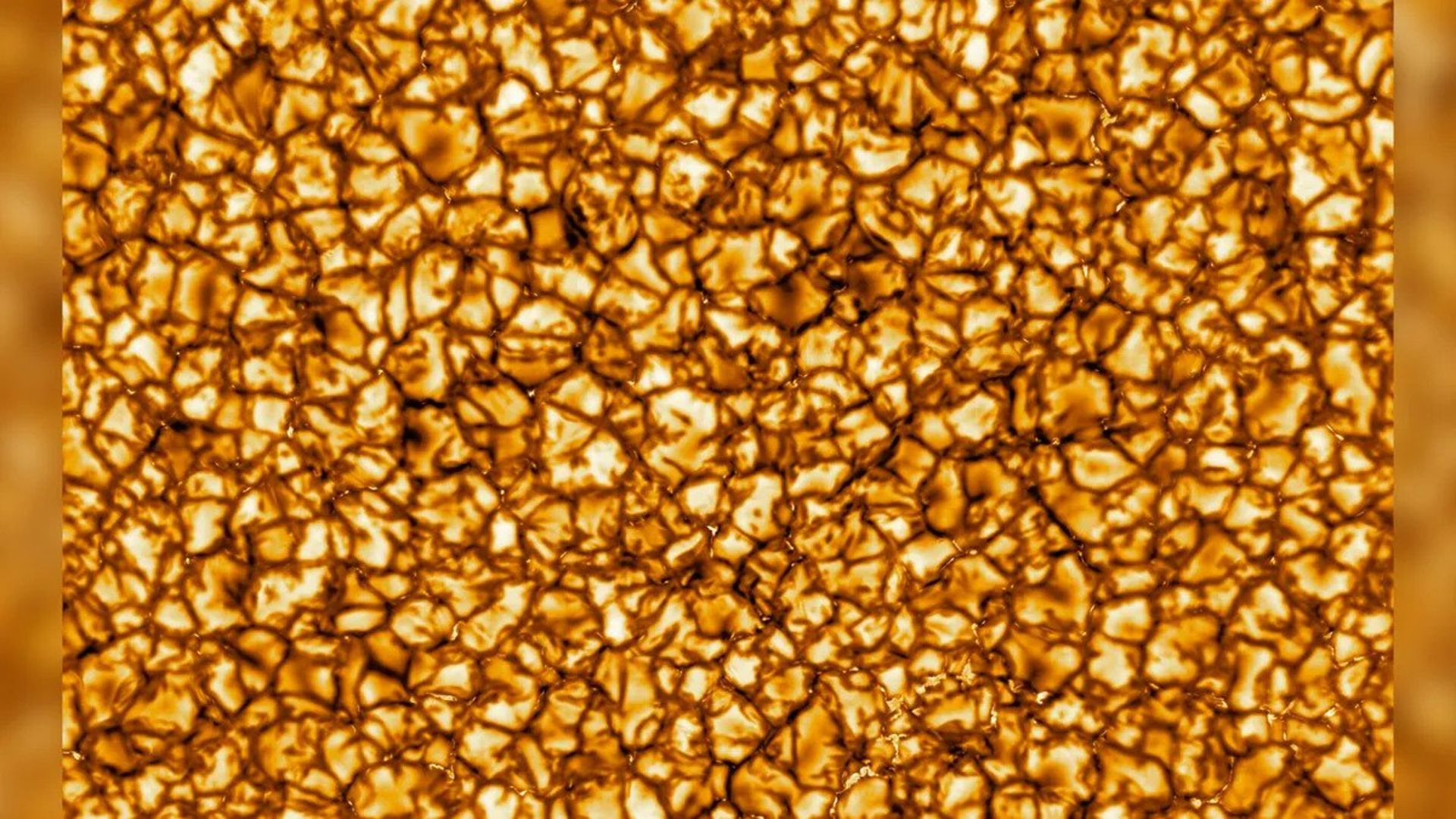 The Daniel K. Inoue Solar Telescope captured this image from the surface of the Sun.
The Daniel K. Inoue Solar Telescope captured this image from the surface of the Sun.
The core of the sun occupies only 2% of its volume; However, its density is 15 times that of lead and it has almost half the mass of the sun. Then we reach the radiative zone, which constitutes 32% of the Sun’s volume and 48% of its mass. The light of the nucleus is scattered in this region so that a photon needs about a million years to pass through it.
Read more: The planet Mercury; Everything you need to know about the closest world to the Sun
The photosphere is the lowest layer of the Sun’s atmosphere and emits the light we see. The photosphere is approximately 500 km thick, although most of its light comes from the lower third. The temperature of the photosphere varies between 6125 degrees Celsius in the lower part and 4125 degrees Celsius in the upper part.
The temperature of the solar corona can reach millions of degrees Celsius
Then we reach the chromosphere, whose temperature can reach 19,725 degrees Celsius and is made up of blade-like structures known as spikes, which have a diameter of 1,000 km and a height of nearly 10,000 km.
Then we reach the transition zone, whose thickness is between several hundred and several thousand kilometers. This region is also heated by the solar corona above it and emits a large part of the light in the form of ultraviolet rays.
Finally, we reach the super-hot solar corona, which has structures such as rings and streams of ionized gas. The temperature of the solar corona varies between 500,000 and 6 million degrees Celsius, and even in the event of a solar flare, this temperature can reach tens of millions of degrees Celsius. Materials from the solar corona are released in the form of the solar wind.
Characteristics of the sun
The Sun’s magnetic field is defined by a combination of three complex mechanisms: a central electric current that runs through the Sun, layers of the Sun that rotate at different speeds, and the Sun’s ability to conduct electric current. Near the Sun’s equator, the magnetic field lines form small rings near the surface. The magnetic field lines that flow through the poles travel thousands of kilometers to reach the opposite pole.
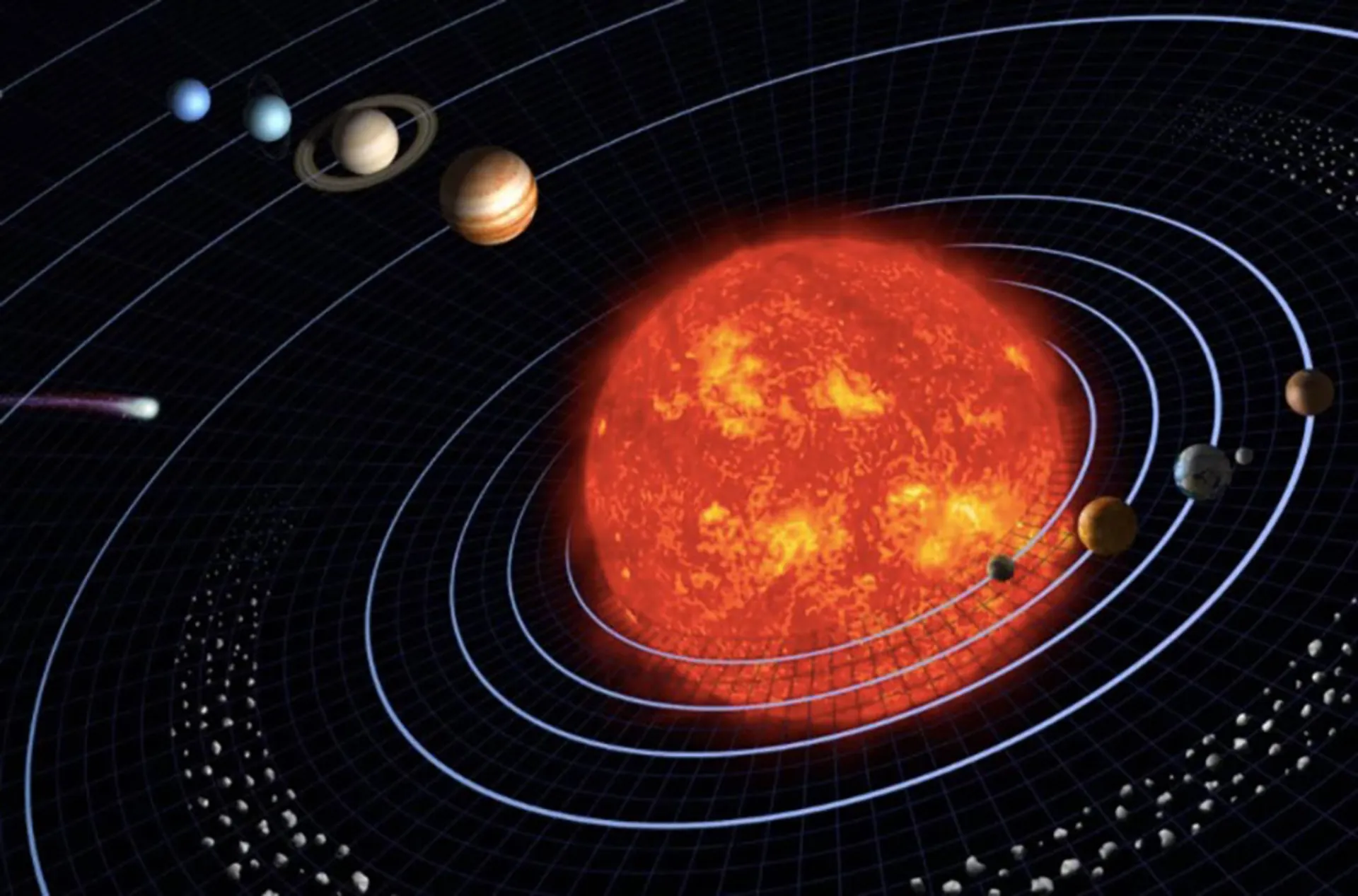 This image shows the sun at the center of the solar system.
This image shows the sun at the center of the solar system.
The Sun’s magnetic field is almost twice as strong as the Earth’s magnetic field. However, it is highly concentrated in some small areas, so that its strength reaches 3000 times the normal level. These changes lead to the creation of features such as sunspots to spectacular eruptions known as flares and mass ejections from the solar corona.
The sun rotates around its axis just like the earth. This rotation is counterclockwise and it takes between 25 and 53 days to complete one rotation. The Sun also rotates clockwise around the center of the Milky Way. The Sun’s orbit is between 24,000 and 26,000 light years away from the center of the galaxy. It takes 225 million to 250 million years for the Sun to make a complete revolution to the center of the galaxy.
What is the size and distance of the sun from the earth?
The sun is approximately 150 million kilometers away from the earth. This distance called an astronomical unit (AU), has become the standard scale for measuring the distance between stars and planets. An astronomical unit can be measured based on the speed of light or the time it takes for a photon of light to travel from the Sun to Earth.
It takes approximately eight minutes and nineteen seconds for sunlight to reach the Earth. The radius of the sun or its distance from the center is approximately 700 thousand kilometers. This distance is about 109 times the radius of the Earth. The Sun is not only larger in radius than the Earth, but its mass is 333,000 times that of the Earth. Also, 99.8% of the total mass of the solar system belongs to the sun.
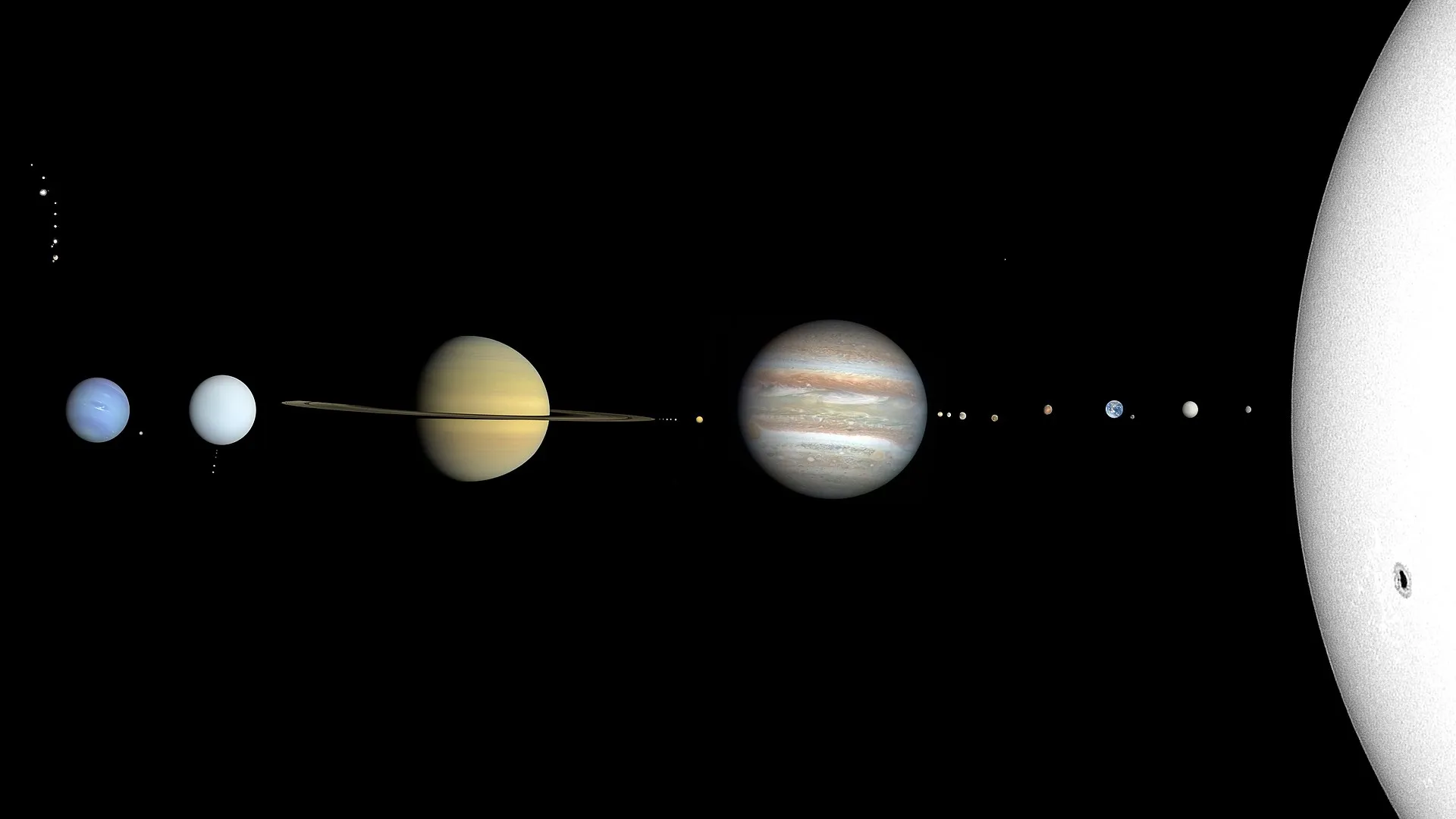 Comparison of the dimensions of the sun compared to the gaseous and rocky planets of the solar system.
Comparison of the dimensions of the sun compared to the gaseous and rocky planets of the solar system.
The influence of the sun on the Earth
The influence of the sun on the earth is very impressive. The sun is responsible for the formation of life on our planet and without it, we would not exist. Plants and animals depend on the sun to grow. Plants obtain their food through a process called photosynthesis. In addition to water and carbon dioxide, the sun helps plants produce glucose. Glucose is a type of sugar that acts as food for plants.
In addition, another product of photosynthesis is oxygen, which plants release from themselves. On the other hand, we humans need oxygen for our lives. For this reason, plants are often called the lungs of the earth. Plants in the oceans, such as phytoplankton and seaweed, use sunlight for photosynthesis. In this way, the ocean produces half of the oxygen in the world. On the other hand, the oceans absorb a large part of the carbon dioxide on the earth.
 Solar energy can be used to provide electricity.
Solar energy can be used to provide electricity.
The sun is the main driver of the Earth’s climate and ocean currents. The heat of the sun is unevenly distributed on the earth. Areas around the equator receive direct sunlight and are therefore warmer than areas near the poles. The heat from the equator moves towards the poles and creates currents. This movement transports nutrients into the oceans and helps regulate the climate.
On the other hand, for humans, the day and night cycle is the basis for daily activities. Humans are often active during the day. Sunrise signals indicate the beginning of the day and sunset signals rest time.
In addition to setting the body clock, the sun has direct benefits on our overall health. Sunlight is good for bones and helps improve our health. Our body produces vitamin D through exposure to direct sunlight. It also helps to produce serotonin, the feel-good hormone and boosts our sense of energy. However, moderation is important, as too much sun exposure can lead to sunburn.
Sunspots and solar cycles
Sunspots are dark and relatively cold spots on the sun’s surface that often have a circular appearance. These spots appear when dense parts of the Sun’s magnetic field lines make their way from the inner space to the Sun’s surface.
The number of sunspots depends on the solar magnetic activity. The change in the number of spots from a minimum to a maximum of 250 spots and then back to the minimum value is called the solar cycle. This cycle repeats almost every 11 years.
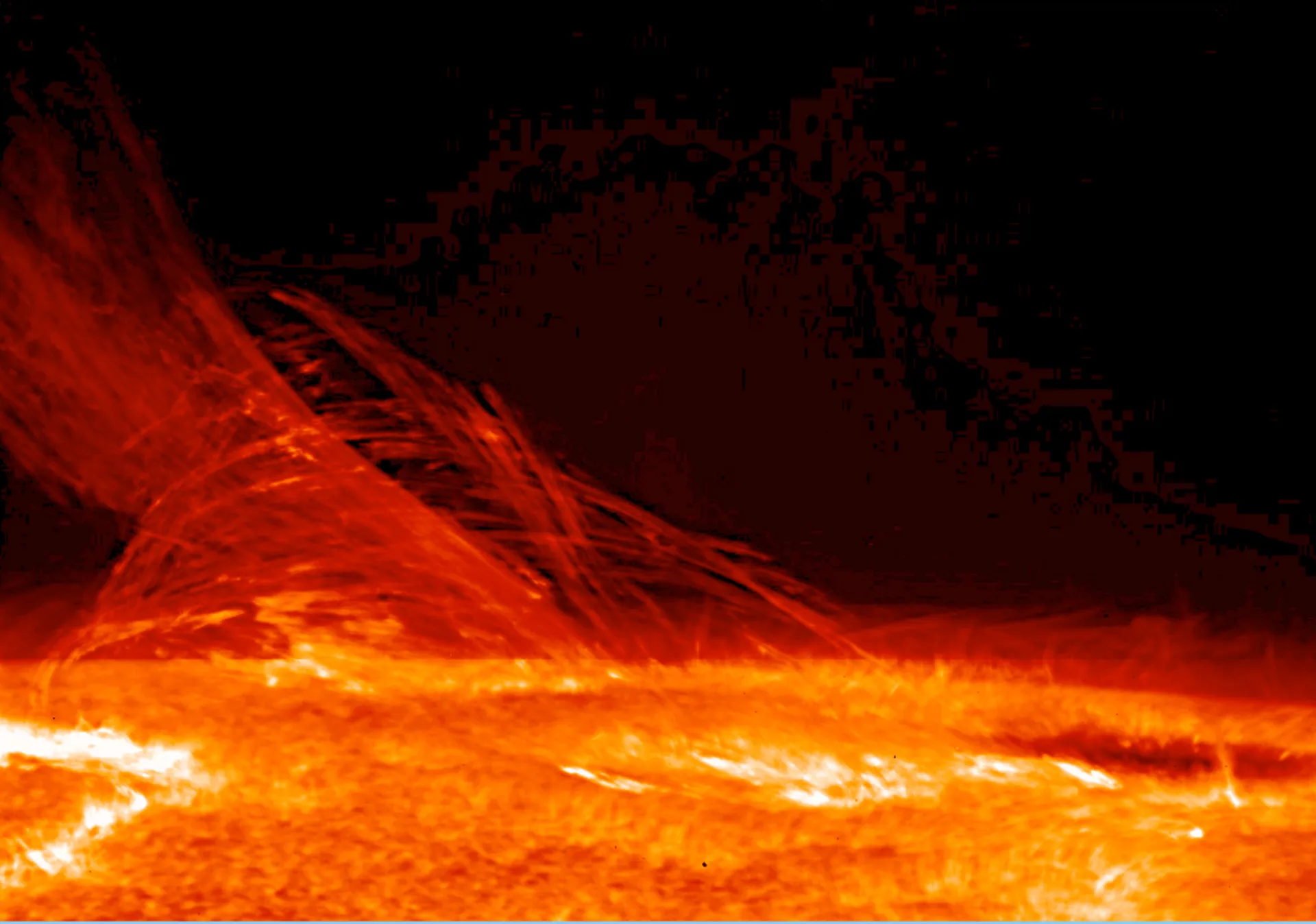 An image of the transition zone of the sun.
An image of the transition zone of the sun.
death of the sun
The Sun is almost halfway through its main sequence life and has been burning hydrogen for 4.5 billion years. Our star is in a constant battle because the external radiation pressure from the nuclear fusion process is always in balance with the external gravitational forces. When the sun’s core hydrogen runs out in about 5 billion years, no force will be able to counter the inward force of gravity.
Finally, the center of the sun undergoes gravitational collapse and turns into a compact core. In the next stage, helium fusion occurs and elements such as carbon, nitrogen, and oxygen are produced. In this way, the sun enters the red giant phase and spreads its outer layers into space. During this phase, the Sun will swallow the inner planets of the Solar System, such as Mercury, Venus, and possibly Earth. Finally, after millions of years, with the release of all the outer layers, the core of the Sun remains in the form of a white dwarf. The white dwarf loses its heat over time and theoretically turns into a cold object called a black dwarf.
 Camelopardalis red giant star. Our sun will become a red giant one day
Camelopardalis red giant star. Our sun will become a red giant one day
Discoveries of the sun
Ancient cultures often altered natural stone structures or built stone monuments to mark the movements of the sun and moon, thus recognizing the seasons, creating calendars, and tracking the process of solar and lunar eclipses. According to the belief of many ancient people, the sun revolved around the earth, so Ptolemy, the ancient Greek researcher, made the central earth model in 150 BC. In 1543, Nicolaus Copernicus presented the sun-central model of the solar system, and in 1610, the discovery of Jupiter’s moons by Galileo Galilei confirmed the hypothesis that all celestial bodies do not revolve around the Earth.
For the first time, Nicolaus Copernicus presented the heliocentric model of the solar system
To learn more about the Sun and other stars, scientists began to study the Sun from Earth’s orbit. NASA launched a series of eight orbiting observatories known as Orbiting Solar Observatory between 1962 and 1971. Seven of them performed successfully and examined the Sun in X-ray and ultraviolet wavelengths. Also, one of their achievements was photographing the super-hot solar corona.
In 1990, NASA and the European Space Agency launched the Ulysses probe to observe the polar regions of the Sun. In 2004, NASA’s Genesis spacecraft returned samples of the solar wind to Earth for research. In 2007, the STEREO dual probe released the first 3D images of the Sun. NASA lost contact with STEREO-B in 2014. SETERO-A continued to operate.
 Artist’s rendering of the Parker Probe.
Artist’s rendering of the Parker Probe.
The Solar and Heliospheric Observatory (SOHO) is one of the most important solar probes designed to study the solar wind and the outer layers and internal structure of the Sun. Among the important achievements of this probe, we can mention the following: photographing the structure of subsurface sunspots, measuring the acceleration of solar winds, discovering corona waves and solar tornadoes, discovering more than 1000 comets, creating a revolution in the human ability to predict space weather.
The Solar Dynamics Observatory (SDO), launched in 2010, has released unprecedented detail of sunspot outflows, as well as close-up images of the Sun’s surface activity and precise measurements of solar flares across a wide range of ultraviolet wavelengths.
The most recent spacecraft added to the Sun Observing fleet are the Parker Solar Probe and the Solar Orbiter spacecraft from NASA and the European Space Agency, which were launched in 2018 and 2020, respectively. Both probes are moving in unprecedentedly close orbits around the Sun, providing complementary measurements of the star’s environment.
On its closest approach to the Sun, the Parker probe entered the Sun’s outer atmosphere, or corona, and withstood its extremely hot temperatures. At its closest, this spacecraft is located at a distance of 6.5 million kilometers from the surface of the sun. The measurements help scientists learn more about the Sun’s energetic currents, the structure of the solar wind, and how energetic particles are accelerated and transported.
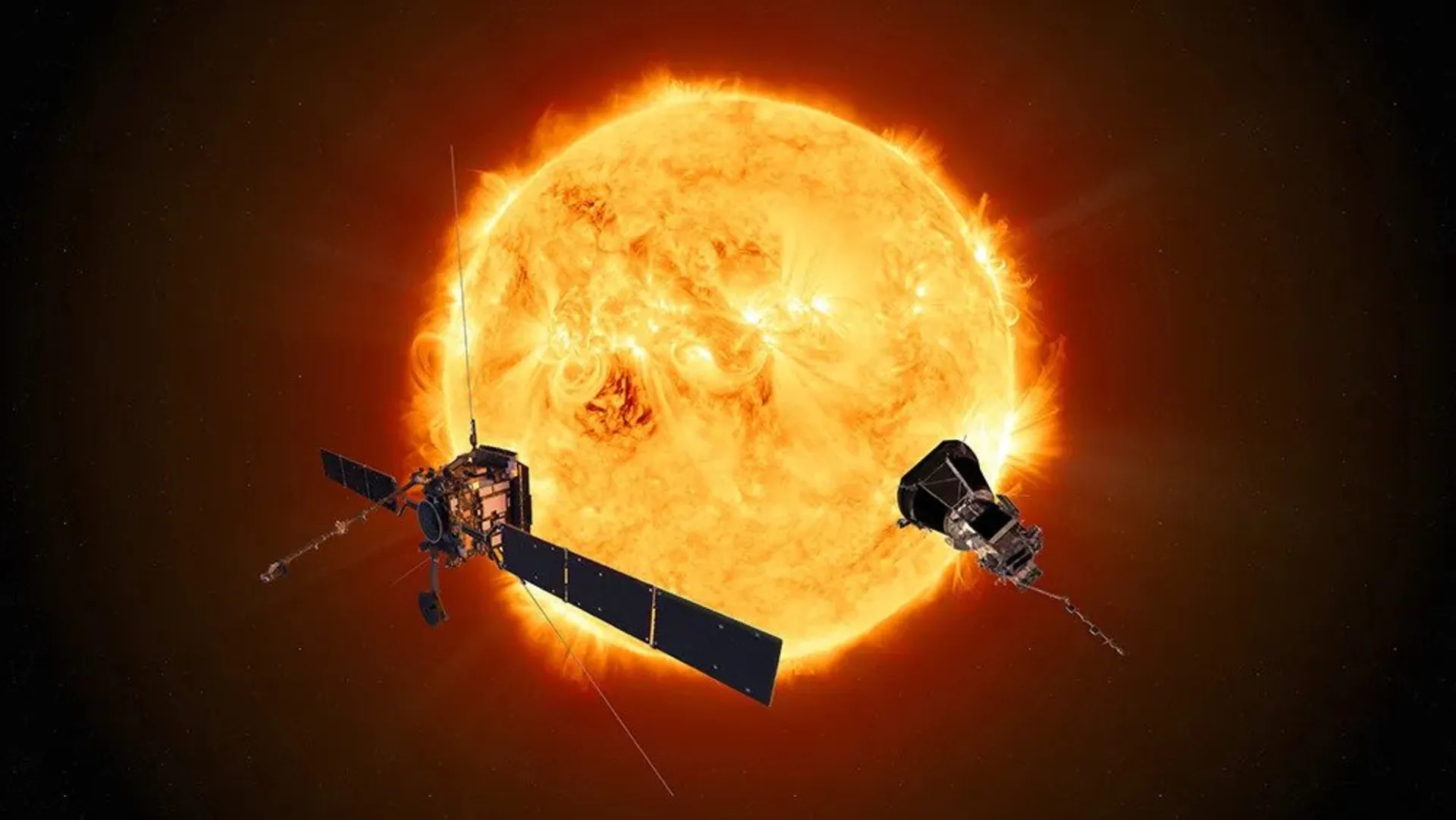 Hypothetical image of NASA solar orbiter with Parker probe.
Hypothetical image of NASA solar orbiter with Parker probe.
Although the Solar Orbiter will not fly as close to the Sun as the Parker Probe, it is equipped with advanced cameras and telescopes that take pictures of the star’s surface as close as possible. It was technically impossible for the Parker probe to carry such a camera to directly photograph the Sun. The Parker probe has also flown through a Coronal Mass Eruption (CME) in its most recent attempt.
Solar Orbiter is closest to the Sun at an altitude of 43 million kilometers from this star, which is 25% closer to the Sun than Mercury. This orbiter has recorded a collection of the closest images to the Sun and unprecedented features such as miniature flares.
Interesting facts about the sun
Up to this section, we have provided almost all the necessary information about the sun. However, there are some facts about this amazing star that you have rarely heard.
- The sun constitutes 99.86% of the total mass of the solar system. The sun has a mass of 330,000 times the mass of the Earth. Three-quarters of the sun is hydrogen and the rest is helium. Therefore, the sun is the heaviest object in the solar system.
- More than a million Earths fit in the Sun. If you were to fill a hollow sun with spherical Earths, it would fit nearly 960,000 Earths inside. However, if you want to make sure that no space is wasted, 1,300,000 crushed Earths fit inside the Sun. The surface area of the sun is 11,990 times the area of the Earth.
- One day, the sun will destroy life on Earth. The sun will eventually run out of hydrogen fuel after five billion years. Finally, this star expands and enters the red giant phase. As a result, the Sun will swallow the planets Mercury and Venus and possibly the Earth.
- The energy produced by the Sun’s core is called nuclear fusion. Most of the sun’s energy is produced when four hydrogen nuclei combine to form a helium nucleus.
- The sun is almost a perfect sphere. Considering the sheer dimensions of the sun, there is only a ten kilometer difference between its polar and equatorial diameters; And this feature makes the Sun the closest object to a perfect sphere in nature.
- The sun is moving at a speed of 220 km/s. The Sun is between 24,000 and 26,000 light-years away from the center of the galaxy. It takes approximately 225 to 250 million years for the Sun to make a complete orbit around the center of the Milky Way.
- The sun will eventually become the same size as the Earth. When the Sun ends its red giant phase, it undergoes internal collapse. The large mass of the Sun is conserved, yet this large mass is condensed into an Earth-sized volume. When this happens, the Sun enters the white dwarf phase.
- It takes eight minutes for sunlight to reach the earth. The average distance between the sun and the Earth is approximately 150 million kilometers. Light travels at a speed of 300,000 kilometers per second, by dividing these numbers we get 500 seconds or eight minutes and twenty seconds. Energy from the Sun reaches the Earth in just a few minutes, but it takes millions of years to reach the surface of the Sun’s core.
- The sun is in the middle of its life. With a lifetime of 4.5 billion years, the Sun has burned almost half of its hydrogen storage and has enough storage for the next 5 billion years. Currently, the Sun is a yellow dwarf star.
- The distance between the Earth and the Sun changes. The reason for this problem is the movement of the Earth in an elliptical orbit around the sun. For this reason, the distance between the Earth and the Sun varies between 147 and 152 million kilometers.
- The sun revolves around the Earth. If you look at the sun from the north, the sun rotates in a counter-clockwise direction, i.e. from east to west. This process is similar to all the planets of the solar system except for Venus and Uranus.
- The rotation of the sun at the equator is faster than the rotation of its poles. This phenomenon is called differential rotation.
- The sun produces the solar wind. These winds are plasma eruptions or very hot charged particles that originate from a layer of the sun called the solar corona. These particles can move at a speed of 450 km/s in the solar system.
- The sun belongs to the group of yellow dwarf stars. The sun is a type of main sequence star with a surface temperature between 5000 and 5700 degrees Celsius, which is included in the group of yellow dwarf stars.
- The auroras are the result of the collision of the solar wind with the Earth’s atmosphere. When the sun’s charged particles collide with the earth’s atmosphere, beautiful aurora borealis in different colors are created, and as the name aurora borealis suggests, they are mostly seen in the polar regions and near the poles.
Conclusion
The sun is the star responsible for the emergence and continuation of life on Earth, which constitutes nearly 99.8% of the total mass of the solar system. This yellow dwarf star, which is in the main sequence stage of its life, was formed about 4.6 billion years ago from a huge cloud of gas and dust. Gradually, the planets formed around the sun.
The sun has a great influence on the earth’s climate and weather, and since thousands of years ago, humans have used the sun to regulate their daily activities. In about 5 billion years, the life of the Sun will end and by entering the red giant phase, the rocky planets will swallow the inner part of the solar system. So far, researchers have sent many probes to the Sun, which have resulted in amazing data on the structure of the Sun.


You may like
-

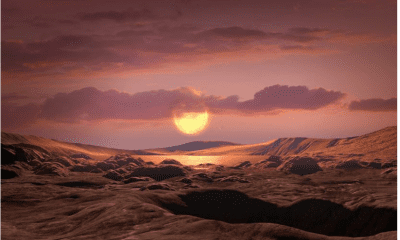


Most alien planets probably do not have day or night
-




The biography of Edwin Hubble
-

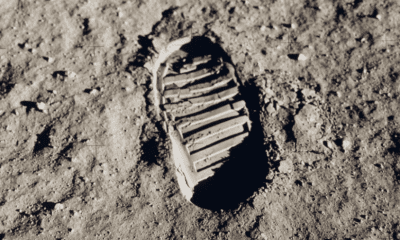


Can telescopes see astronaut footprints on the moon?
-




Can you really see the Great Wall of China from space?
-

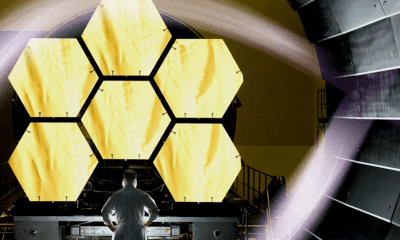


The James Webb Space Telescope; A look at the vastness of the universe
-

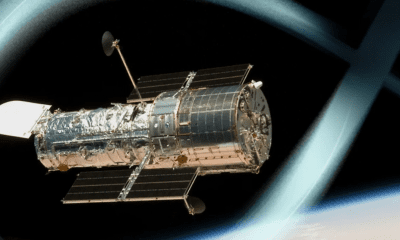


Hubble Space Telescope; A portal to the mysterious depths of the universe


Most alien planets probably do not have day or night
Do aliens sleep? You may take sleep for granted, but research suggests that many possible life-hosting planets may not have a day-night cycle. It is difficult to imagine the absence of day and night, but right now on Earth there are creatures living in lightless habitats in the depths or on the seabed, and they offer a vision of alien life without the existence of a circadian rhythm.
There are billions of potentially habitable planets in our galaxy; But how do we get to this number? The Milky Way has between 100 billion and 400 billion stars, seventy percent of which are cold and small red dwarf stars or M dwarfs.
According to a detailed survey of exoplanets in 2013, approximately 41% of red dwarf stars have a planet in their life belt. At this distance, the planet has the right temperature to support liquid water; Therefore, these planets have the potential to host liquid water.
We still do not know which of the discovered exoplanets have liquid water. However, 28.7 billion planets are only in the red dwarf life belt. We have not even considered the statistics of other types of stars like our sun.
 Planets close to red dwarfs are fatally locked to their star
Planets close to red dwarfs are fatally locked to their star
Rocky planets in the habitable belt of an M dwarf are called M Earths. M-Earths are fundamentally different from our Earth. One difference is that M dwarf stars are much cooler than our Sun. Also, M Earths are located at a close distance from their star, and for this reason, the gravitational influence of the star on them is strong.
The star’s gravity exerts a stronger force on the near side of the planet than on the far side. By creating friction, the planet’s rotation slows down until its orbital and translational rotations become synchronized over millions of years. Thus, M fields are likely to be deadlocked; So that one hemisphere of them is always facing the star and the other hemisphere is always behind it.
The year of a mortally locked planet is as long as its day. Earth’s moon also has a deadly lock on us. For this reason, we always see one side of it and cannot observe its hidden side.
A planet in mortal lock looks strange, But most possible habitable planets are of this type. Our nearest planetary neighbor, Proxima Centauri b, located in the Alpha Centauri system four light-years from Earth, is likely a fatally locked M-Earth.
As a result, unlike our Earth, M Earths have no day or night and even seasons; But terrestrial life, from bacteria to humans, has circadian rhythms corresponding to the day and night cycle. Sleep is one of the most obvious consequences of circadian rhythm.
On Earth, some creatures live in absolute darkness
The circadian cycle affects biochemistry, body temperature, cell regeneration, behavior, and much more. For example, people who are vaccinated in the morning produce more antibodies than people who are vaccinated in the afternoon; Because the response of the immune system is different during the day.
We cannot yet say with certainty how much periods of inactivity and regeneration affect life. Perhaps organisms that evolved without cyclical time never needed to rest.
If you doubt it, you can look at terrestrial organisms such as cave dwellers, deep sea life, and microscopic organisms in dark environments such as the earth’s crust and the human body that thrive in space away from daylight.
Many life forms have biological rhythms that are synchronized to stimuli other than light. Naked burrowing mice spend their entire lives underground and never see the sun, But their day and night hours are proportional to the daily and seasonal cycles of temperature and rainfall. Also, deep-sea bivalves and thermal well shrimps coordinate with ocean tides.
Bacteria that live in the human gut synchronize with melatonin fluctuations in the host’s body. Melatonin is a hormone in the body that is produced in response to darkness. Temperature changes that occur in thermal wells, humidity fluctuations chemical changes, and environmental currents can all cause biological fluctuations in the body of living organisms.
According to new research, M-Earths can have alternate cycles for days and seasons. To evaluate days and seasons on exoplanets, scientists have adapted climate models to simulate the environment of M-Earths and planets such as Proxima Centauri b.
According to the simulations, the contrast between the night and day sides of the planets produces gusts and atmospheric currents similar to Earth’s gust currents. If a planet has water, its dayside is likely to have thick thunderclouds.
The interaction between winds, atmospheric waves, and clouds can change the climate and produce regular cycles of temperature, humidity, and rainfall. The length of these cycles varies from hundreds to thousands of Earth days depending on the state of the planet, But it has nothing to do with the rotation period of the planet. Although the stars in the sky of these planets remain constant, the environment changes.
Perhaps life on M-Earths evolved to match biological rhythms and climatic cycles, or perhaps evolution arrived at a more exotic solution. One can imagine species that live on the day side of the planet going to the night side to rest and regenerate themselves.
These descriptions remind us that if life is out there, it can challenge assumptions we don’t know exist. The only certainty is that it will surprise us.


nameNoun: Any nounal word or phrase which indicates a particular person, place, class, or thing.
Noun: reputation.
Noun: An abusive or insulting epithet.
Noun: A person (or legal person).
Noun: Those of a certain name; a race; a family.
Noun: authority; behalf.
Noun: A unique identifier, generally a string of characters.
Noun: An investor in Lloyd’s of London bearing unlimited liability.
Verb: To give a name to.
Verb: To mention, specify.
Verb: To identify as relevant or important
Verb: To publicly implicate by name.
Verb: To disclose the name of.
Verb: To designate for a role.
Verb: To initiate a process to temporarily remove a member of parliament who is breaking the rules of conduct.
Noun: Any of several types of true yam () used in Caribbean Spanish cooking.
SProper noun: in which several of the axioms of ZF are derivable as theorems.
Noun: Any nounal word or phrase which indicates a particular person, place, class, or thing.
Noun: reputation.
Noun: An abusive or insulting epithet.
Noun: A person (or legal person).
Noun: Those of a certain name; a race; a family.
Noun: authority; behalf.
Noun: A unique identifier, generally a string of characters.
Noun: An investor in Lloyd’s of London bearing unlimited liability.
Verb: To give a name to.
Verb: To mention, specify.
Verb: To identify as relevant or important
Verb: To publicly implicate by name.
Verb: To disclose the name of.
Verb: To designate for a role.
Verb: To initiate a process to temporarily remove a member of parliament who is breaking the rules of conduct.
Noun: Any of several types of true yam () used in Caribbean Spanish cooking.
The biography of Edwin Hubble, the legendary astronomer who discovered the extragalactic space
Edwin Powell Hubble known as Edwin Hubble was a famous American astronomer who played an important role in formulating the basic principles of extragalactic and observational astronomy. Historians and astronomy experts consider him one of the most important astronomers in history. Hubble placed the space clouds, which before her time were known as gas and dust particles and were in the category of nebula or nebula, in the category of galaxies.. Historians consider Hubble’s discovery of other galaxies equal to Copernicus’ theory in terms of scientific value. Copernicus proved that the Earth is not at the center of the solar system, and Hubble proved that the Milky Way is not the center of the universe.
One of the important scientific relics of this astronomer is Hubble’s law in space. In short, this law states that the universe is expanding at a constant rate. In addition, in this law, the distance of each galaxy from the edge of the universe is directly proportional to its speed. Of course, this law was discovered two years before Hubble’s presentation by Georges Lemaitre, but its fame came to Hubble. The Hubble telescope is one of the most famous monuments built in the name of this legendary astronomer. An example of this telescope is installed in his hometown of Marshfield, Missouri. This telescope was sent into Earth orbit in 1990 to capture more detailed images of space outside the Milky Way.
Edwin Hubble has another great achievement in the field of cosmology and that is the classification of galaxies. This classification has been used by astronomers for many years. Hubble played a significant role in adding the astronomy category to the Nobel Prize. Of course, the sudden death of this scientist in 1953 prevented him from receiving this award.

Birth and education
Edwin Hubbell was born on November 20, 1889, in Marshfield, Missouri. His mother was Virginia Lee James and his father was John Powell Hubble. His father was a lawyer and insurance businessman. Edwin was the third child out of 8 children in this family. Of course, like many children of those years, some of Edwin’s siblings died in childhood.
Hubbell lived in a rich family that had to migrate many times because of his father’s work style. During these trips, which were generally in cities around Chicago and Illinois, they lived in luxurious houses with many servants. The children of the Hubble family were all brought up with work and responsibility; Because their parents believed that this style of upbringing would increase their sense of responsibility.
Edwin Hubble was very interested in sports as a child and teenager
As a child, Edwin struggled to keep up with his older siblings and students, so he learned to read before school. He was very fond of adventure books by Jules Verne and H. Rider Haggard. Edwin’s grandfather was an amateur but enthusiastic astronomer. At the age of 7, he got acquainted with one of his grandfather’s telescopes and had his first experience of space exploration. The interesting thing is that instead of participating in the celebration, he observed the space with this telescope on his 8th birthday.
Hubble completed his high school education at Wheaton High School near Chicago. He finished high school easily and with excellent grades in English, mathematics, biology, chemistry, physics, Latin, and German languages. Of course, in high school, Edwin was more into sports than studying, and he owed his high grades to his innate intelligence. On his father’s advice, he was busy delivering goods on holidays. Finally, Edwin Hubbell graduated from high school in 1906 at the age of 16 and received a scholarship to the University of Chicago. He worked at this university as a laboratory assistant of the famous physicist Robert Millikan (Nobel Prize winner).

Edwin Hubble (left), with friends after returning from Oxford
After entering the university, sports still occupied a large part of Hubble’s time. He was fond of sports such as basketball and boxing. He was a tall and strong person and he left several records during his university days. Edwin Hubble graduated from the university in 1910 with a bachelor’s degree in general science and honors in physics and astronomy.
After graduating from the University of Chicago, Hubbell entered Oxford University with a Rhodes scholarship and studied there for three years. Hubble was quickly influenced by English culture and changed many of his past behaviors and habits and adopted an English appearance. Contrary to his strong interest in experimental sciences and especially astronomy, he chose the field of law theory out of respect for his father and graduated from Oxford in 1912. He stayed at this university for another year and studied Spanish. While studying at Oxford, Hubble had another achievement including traveling around Europe. In these trips, in addition to having fun, he paid special attention to planning and thinking about his future. In those years, Edwin wrote in a letter to his mother:
Work is pleasant when it is for a great purpose and end. A goal so great that the thought of it and the anticipation of its achievements, will remove all the fatigue of the difficult task. When I find the purpose and principles I want, I leave everything for it and dedicate my life to it.
Edwin’s father died in the fall of 1912. He asked his father for permission to leave Oxford to visit him but was refused. Young Edwin remained in Oxford and his father died in January 1913.

Hubble exploring the cave
His Career
Hubble’s first job was teaching high school Spanish and physics.
Edwin Hubble returned to America in the summer of 1913. He was employed as a Spanish and Physics teacher at New Albany High School in Indiana. In addition, he coached the school’s basketball team and had a part-time job as a German translator. Although Hubble was a popular teacher, he did not enjoy his job. For this reason, he corresponded with Forrest Ray Moulton, professor of astronomy at the University of Chicago, and asked him for advice on collaborating on astronomy projects and higher education in this field. Moulton also introduced Hubble to Edwin Frost, director of the Yerkes Observatory in Wisconsin. In his letter, he introduced Hubble as a hardworking person, enthusiastic about science, and useful to Frost.
Finally, at the age of 24, Edwin entered the field of science, which he had become interested in nearly two decades ago by observing space through the lens of his grandfather’s telescope. Upon entering the observatory, he began his doctoral course in astronomy and received his degree in 1917 with a thesis entitled Photographic Investigations of Faint Nebulae. With the outbreak of World War I, Hubble served in the army for a year and rose to the rank of colonel despite not being actively involved in combat. He then went to Cambridge University to study astronomy.
Edwin Hubble started working at the Mount Wilson Observatory in California in 1919 at the age of 30. This observatory is famous for its excellent weather and excellent observation conditions. These factors made Hubble research in this place until the end of his life.

Hubble membership card in the army
Scientific achievements
As mentioned, Hubble wrote his doctoral dissertation on nebulae. He continued his research at Mount Wilson using the world’s largest telescope, the Hooker telescope. Hubble’s great discoveries, including galaxies beyond the Milky Way and the phenomenon of redshift, were the results of this astronomer’s research using the Hooker telescope.
In 1912, the American astronomer Henrietta Leavitt published an important discovery related to stars called the Cepheid variable. Beginning in the 1930s, Hubble was able to discover similar stars in nebulae using the Hooker telescope. While studying the Andromeda Nebula, he realized that these stars are very far from Earth and much farther than the stars of the Milky Way.
The discovery of other galaxies and the greatness of the universe was the greatest achievement of this scientist
Eventually, Hubble discovered that the Andromeda Nebula is actually a galaxy. Until then, most astronomers believed that the Milky Way and the Universe were a single entity. Hubble discovered that the universe is much larger than the Milky Way and consists of “island universes”. His findings in this historical discovery are summarized as follows:
- His high-quality images of Andromeda and the Triangulum Nebula showed a massive cluster of stars.
- Many of the stars were of the Cephasian type.
- The studied nebula is one million light years away from Earth. 4 times more than all the objects that had been discovered until that time. (Of course, this distance is proven to be equal to 2.5 million light-years today.)
- The diameter of the Andromeda Nebula is 30 thousand light years. (Today, these dimensions have been proven to be 220,000 light years.)
- Andromeda galaxy emits light equal to one billion suns of our system.
Hubble published his findings three days after his 35th birthday. Of course, his discoveries were not published in a scientific journal, but in the New York Times. The results of his research were debated among astronomers for some time, and finally, his paper was reviewed at the meeting of the American Astronomical Society on January 1, 1925. Hubble changed everyone’s view of the universe with his discoveries. He proved that our vast galaxy, host to the Sun and hundreds of billions of similar stars, is only one of the billions of galaxies in the universe.

Andromeda Galaxy
In addition to this discovery, Hubble provided a standard for classifying galaxies that was used by astronomers for years.
Redshift phenomenon
Prominent astronomer Veslu Slifer has also researched nebulae. He stated in his report in 1913 that the light of the nebula tends towards the red color of the color spectrum. He explained his discovery as a form of the Doppler effect. According to the same explanation, the light tends to the red side of the color spectrum as the emission source moves away, similar to the Doppler effect. To test his discovery, Slifer studied many nebulae. He came to the conclusion that the light of many of these nebulae has a fast transition towards red color and as a result, they are moving away from Earth at a high speed.
Hubble stated that galaxies are moving away from each other at high speed
In 1929, using Slifer’s findings and combining them with his own discoveries and his assistant Milton Humson’s, Hubble was able to find an explicable relationship between galaxy distance and redshift state. He recorded his findings in a formula known today as Hubble’s law. This formula is displayed as v = Hr, where v is the velocity, r is the distance, and H is Hubble’s constant. This constant was first named as 530 by Hubble, but today, using advanced research and tools, the exact number is 70.
The world is expanding
One of the main interpretations of Hubble’s law is that we live in an expanding universe. Of course, Hubble himself believed that there is not enough credible evidence to prove this interpretation of the redshift effect. The remarkable point is that although Hubble drew the attention of the scientific community to this law, the law was discovered two years earlier by Georges Lemaitre. In fact, Lemaitre’s interpretation of this law is more accepted by new cosmologists; Because he used Einstein’s law of relativity for his interpretation.
However, Hubble’s point of view was quite logical. He believed that the theory of red shift can only be accepted as a proof of the expansion of the universe when the density of matter in the universe is much higher than the amount discovered up to that time. These statements have been the basic foundations for the proof of dark matter in the universe. Hubble said about the density of materials needed to prove the effect of redshift:
The required density of matter is several times higher than the estimated maximum density of matter concentrated in the nebula. Furthermore, we have no evidence of significant interstellar matter increasing the density.

Classification of galaxies by Hubble
However, although Hubble had a lot of resistance to accept the effect of redshift, in his research he found that the speed of this expansion is slowing down. However, these findings and research on the speed of galaxy expansion are still ongoing and astronomers discover new issues every day.
One of the historical events regarding the theory of the expanding universe is Albert Einstein’s meeting with Edward Hubble in 1931. The two met at Mount Wilson Observatory. In 1917, in his theory of relativity, Einstein considered the universe to be constant and without change in size. He did not see any end or end to the universe. Although his research showed signs of the expansion of the universe, this scientist tried to deny it by determining a constant called the cosmic constant.
However, the January 1931 meeting earned Hubble the nickname of the man who forced the world’s smartest man to change his mind. This meeting caused Einstein to call his previous calculations the biggest mistake of his scientific life, and as a result, Hubble’s findings became the center of attention in scientific circles.
The Big Bang theory is influenced by the findings of this scientist about the expansion of the universe
In 1935, Hubble discovered the 1373 asteroid named Cincinnati. A year later he published the book ” The Realm of the Nebulae “. This book is a historical interpretation of his experiences and research on intergalactic astronomy. With the outbreak of World War II, Hubble once again served in the US Army at the Aberdeen Proving Ground. He was in charge of the ballistics research department in this area. His extensive research resulted in several improvements in the power of ballistic bombs and projectiles. One of his major practical achievements in this research was the improvement of ballistic projectile components, which resulted in a high-speed camera to study the characteristics of the bomb after launch. After the war, Hubble returned to Mount Wilson and spent some time at the Palomar Observatory in California.

Edwin Hubble in old age
In addition to scientific research, Edwin Hubble worked hard to convince the Nobel Prize Society to add astronomy to the award’s branches. He intended to add this science to this event as an independent subsection of physics. He believed that the efforts of astronomers in stellar physics should be appreciated. Unfortunately, after Hubble’s death, this society decided to appreciate this science as a branch of physics.
Personal life and death
Edwin Hubbell married Grace Burke Leib in 1924 at the age of 34 . They had no children. One of Hubble’s pastimes was collecting books. He was generally interested in books related to the history of science. In addition to scientific research, Hubble was also a member of the Board of Trustees of the Huntington Library in San Marino. The discovery of distant galaxies made him so famous that in 1948 his picture appeared on Time magazine. He and his wife had a close relationship with Hollywood stars and artists such as Aldous Huxley.
In 1949, at the age of 59, Edwin Hubbell suffered a heart attack while on vacation in Colorado and was nursed back to health by his wife. Of course, after this incident, the intensity of his research activities decreased until he died on September 28, 1953, due to a blood clot in the brain. He had willed that his burial place should not be known and personal notes were also destroyed by his wife. Grace also died in 1980 and was buried in a secret place next to her husband.
Awards and honors
The Cleveland Newcomb Prize was awarded to Edwin Hubble in 1924. In 1938, he was awarded the Bruce Medal, and a year later, he was awarded the Franklin Medal Science and Engineering Award by the Franklin Institute in Philadelphia. The Gold Medal of the British Royal Astronomical Society was awarded to this legendary astronomer in 1940. The Legion of Honor, which is a military award from the US Armed Forces, was awarded to him in 1946 for his research in the field of ballistics.

Hubble Space Telescope
After the death of Edwin Hubble, in addition to the aforementioned awards, other honors were also registered to pay tribute to this American scientist. The Missouri City Hall of Fame inducted Edwin Hubbell in 2003. In 2008, a commemorative stamp was printed in the name of this scientist, and in 2017, the Indiana Basketball Hall of Fame registered Hubble’s name.
Asteroid number 2069 and a hole in the moon are among the celestial objects that are registered in the name of this scientist. A planetarium at Edward R. Morrow High School in Brooklyn was also named after this scientist, and a street in Missouri was named after Edwin Hubble.
Certainly, the most famous monument of Edwin Hubble is the Hubble Space Telescope, which was launched in 1990. The main purpose of launching this telescope was to accurately calculate Hubble’s constant in his famous formula. Anyway, astronomers with this telescope first considered the number 72 as a constant in 2001, and then in 2006, by studying the microwave background of the galaxy, they reached the exact number 70. In addition, the Hubble telescope made it possible to observe not only the expansion of the universe but also the acceleration of this expansion. Today, the force that caused this expansion is called dark energy in scientific documents.


Can telescopes see astronaut footprints on the moon?
In the early 2000s, when there were occasional people who believed that the moon landing was a hoax, the argument was made that if NASA’s Hubble Space Telescope was powerful enough to see the tiny details of distant galaxies, why couldn’t it take the shoes of the Apollo astronauts on the moon?
The aforementioned argument, like many conspiracy theories, seems convincing on the surface; But with the slightest scrutiny, it loses its value. Those who are fooled by this claim are wrong about two things: how telescopes work and how big space is.
Astronomer Phil Platt explains on the Scientific American website that many people think a telescope’s job is to magnify images. Of course, manufacturers of cheap telescopes like to advertise them this way, printing statements like “150x magnification power” in big letters on the box of the telescopes, along with very misleading pictures of much larger telescopes. Although magnification is important, the true power of a telescope is in its resolution. This difference is subtle but very important.
Magnification is how much you can focus on an object and make it appear larger. This is important because while astronomical objects are physically very large, they are very far away and thus appear small in the sky. Magnifying them makes them easier to see.
Magnification is important, but the true power of a telescope is in its resolution
On the other hand, clarity or resolving power is the ability to differentiate between two objects that are very close together. For example, you might think of two stars orbiting each other (a binary star) as one star; Because their distance is very small and the naked eye cannot distinguish them. But if you look at them with a higher-resolution telescope, you may be able to see that they are two separate stars.
Isn’t that the Zoom? No; Because zooming in only makes everything bigger. This can be easily illustrated with the following image: zoom in as much as you want on the image, but once you pass a certain limit, you only enlarge the pixels and get no new information. To overcome this obstacle, you need to have high resolution rather than zoom.
 Hubble Space Telescope image of the Apollo 17 landing area in the Taurus-Lytro Valley of the Moon. This image lacks the necessary resolution to show the traces of the moon landing or the movement of astronauts on the moon.
Hubble Space Telescope image of the Apollo 17 landing area in the Taurus-Lytro Valley of the Moon. This image lacks the necessary resolution to show the traces of the moon landing or the movement of astronauts on the moon.
The problem is that resolution depends on the telescope itself, meaning that a dramatic increase in resolution usually requires a much larger telescope; But no matter how big your telescope gets, it will still have limited resolution.
When light from an infinitesimal point, such as distant stars, passes through a telescope, the light is slightly scattered within the telescope’s optical instruments (mirrors or lenses). This fundamental property is called light diffraction and is unavoidable. The resolution of telescope images depends partly on the size of its mirror or lens. The larger the telescope’s light-gathering instrument, the higher its image resolution.
The way light propagates in optical equipment depends on wavelength, with shorter wavelengths producing higher resolution. So two nearby blue stars may be distinguishable in a telescope, while two red stars at the same distance may not be distinguishable.
When deciding on the size of a telescope’s camera pixels, astronomers must consider the wavelength they want to observe. Otherwise, they just magnify the noise; Like the previous example about zooming too much on the photo.
All these lead to an amazing result. The Hubble Space Telescope has a mirror with a diameter of 2.4 meters and the James Webb Space Telescope (JWST) has a mirror with a diameter of 6.5 meters. Therefore, the resolution of the James Webb telescope images can be expected to be much higher. At some wavelengths, it is: the shortest wavelength that the James Webb Space Telescope can see is about 0.6 microns (what our eyes perceive as orange light), and the resolution is technically much better than that of the Hubble image.
However, the James Webb Space Telescope was designed as an infrared telescope. At those wavelengths, say around two microns, the resolution is comparable to what Hubble can see at visible light wavelengths. In the mid-infrared, i.e. wavelengths of 10 to 20 microns, the resolution of the James Webb Space Telescope images is even lower. However, because the James Webb is the largest infrared telescope ever sent into space, it can provide the sharpest images we’ve ever had at these wavelengths.
 No telescope on Earth or in low Earth orbit can capture an image like this, a high-resolution view of a boot on the moon’s surface.
No telescope on Earth or in low Earth orbit can capture an image like this, a high-resolution view of a boot on the moon’s surface.
Astronomers measure resolving power as an angle on the sky. From the horizon to the highest point of the sky is 90 degrees and each degree is divided into 60 arc minutes and each arc minute into 60 arc seconds. For example, the angular diameter of the moon from our point of view in the sky is about half a degree. That is, if we look at the moon from the Earth, the moon in the sky occupies a space equal to half a degree of the full circle of the sky, which is equivalent to 30 minutes of arc or 1800 seconds of arc.
The maximum resolution of a telescope refers to the smallest angular distance between two objects that the telescope is able to distinguish as two separate objects. This resolution is expressed as an angle.
At its best, the resolution of the Hubble telescope is about 0.05 of an arc, which is considered a very small angle. But the amount of detail Hubble is able to see depends on the distance and physical size of the target. For example, 0.05 seconds of arc is equivalent to the apparent size of a small coin that can be seen from about 140 km.
In this way, we return to the discussion of conspiracy theorists and their claims regarding the observation of astronaut footprints on the moon. Galaxies are usually tens of millions or even billions of light years away from Earth. At those distances, the Hubble telescope can distinguish objects with dimensions of several light years (i.e. tens of trillions of kilometers) with its best resolution. So even though it looks like we’re seeing galaxies in great detail in those amazing Hubble images, the smallest we can see is still pretty big.
At the same time, the moon is only about 380 thousand kilometers away from us and from the Hubble telescope. At this distance, the resolution of the Hubble telescope is surprisingly limited, unable to resolve objects smaller than about 90 meters. As a result, not only can we not see the astronauts’ footprints in the Hubble images, but we can’t even see the Apollo moon landings, which are about four meters across. Hubble’s resolution at this distance is so limited that it cannot distinguish details smaller than about 90 meters, so it is not possible to see objects smaller than this on the Moon.
 An image of the Apollo 11 landing site captured by NASA’s Lunar Reconnaissance Orbiter (LRO). Although the LRO telescope uses much smaller lenses than the Hubble Space Telescope, its proximity to the lunar surface has made it possible to see details such as the Apollo 11 lunar lander and astronauts’ footprints.
An image of the Apollo 11 landing site captured by NASA’s Lunar Reconnaissance Orbiter (LRO). Although the LRO telescope uses much smaller lenses than the Hubble Space Telescope, its proximity to the lunar surface has made it possible to see details such as the Apollo 11 lunar lander and astronauts’ footprints.
In the images taken by the Nass Lunar Reconnaissance Orbiter (LRO), we can see the moon landings and the footprints of the astronauts. Although the camera of this orbiter has a mirror with a diameter of only about 20 cm, the spacecraft is in lunar orbit and passes the Apollo landing sites at an altitude of 50 km.
The reason NASA’s Lunar Reconnaissance Orbiter can see more detail on the surface of the moon is because it is so close to the surface of the moon. This is why we send probes to planets: it allows us to get much better pictures of them. Sometimes, there’s no substitute for being there.
The lesson we learn from this topic is that the way tools actually work is often more complex and different than we expect. Furthermore, claims that may seem reasonable fall apart with a little scientific scrutiny. If a telescope is only advertised based on magnification, it’s best not to buy it and look for other options. It may seem difficult, but with a little determination, you will succeed.


Do animals have an understanding of the concept of death?


What is Kali Linux? Everything you need to know about this popular but mysterious distribution


Sony Brand Story; From the production of rice cookers to becoming one of the most famous companies in the world


How did the people of the past imagine the future?


Mammoth and dodo return to nature


Canopus; What do we know about the second brightest star in the sky?


How to use iMessage on Android?


Can humans endure the psychological torment of living on Mars?


Xiaomi Glorimi M2 Max watch review; Alternative economic option for iPhone owners


Artificial intelligence problems; Frauds based on artificial intelligence and methods to deal with them
Popular
-



 Technology1 year ago
Technology1 year agoWho has checked our Whatsapp profile viewed my Whatsapp August 2023
-



 Technology1 year ago
Technology1 year agoSecond WhatsApp , how to install and download dual WhatsApp August 2023
-



 Technology1 year ago
Technology1 year agoHow to use ChatGPT on Android and iOS
-



 AI2 years ago
AI2 years agoUber replaces human drivers with robots
-



 Technology1 year ago
Technology1 year agoThe best Android tablets 2023, buying guide
-



 Technology1 year ago
Technology1 year agoThe best photography cameras 2023, buying guide and price
-



 Humans2 years ago
Humans2 years agoCell Rover analyzes the inside of cells without destroying them
-



 Technology1 year ago
Technology1 year agoHow to prevent automatic download of applications on Samsung phones
